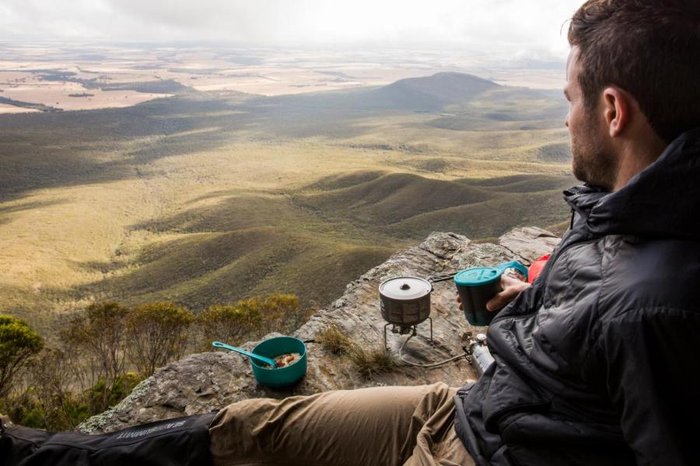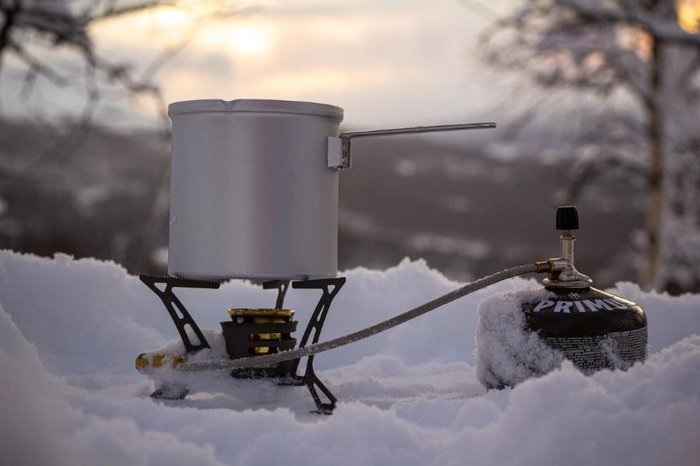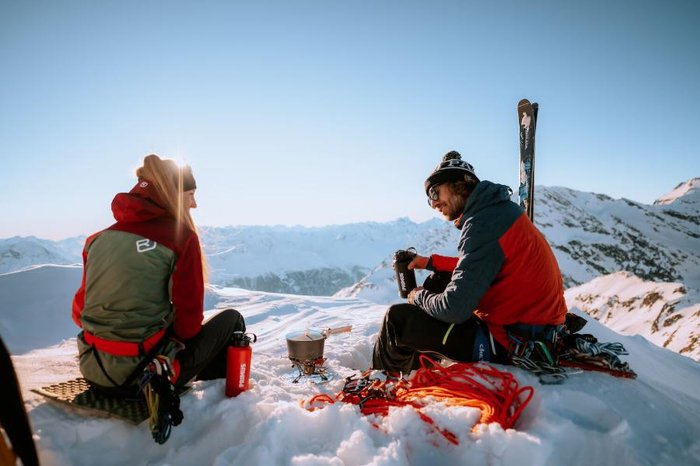Are you looking for a camping stove to complete your backpacking cooking equipment? From summer backpacking trips to polar expeditions, gas, cartridge, multi-fuel, you’ll find stoves for a wide range of needs and tastes at Glisshop. However, on an ever-growing market, it can sometimes be difficult to know if you are contemplating the right model. Ignition and fuel types, power/weight ratio are among the numerous elements to consider when choosing a backpacking stove.

Key Points
- Choose your stove according to the fuel type and intended conditions of use.
- Gas stoves are simple, reliable and suitable for most hiking and backpacking trips.
- Remote or high-efficiency models provide greater stability and improved performance.
- Multi-fuel stoves remain essential in cold environments or for remote expeditions.
- Weight is a key factor: from ultra-lightweight to more durable designs depending on your activity.
- Gas is ideal in mild weather; liquid fuel works in all temperatures.
- Power output determines the boil time, but also increases fuel consumption.
- Depending on your activity: gas for occasional use, integrated systems for trekking, multi-fuel for extreme conditions.
The various types of stoves
Gas trekking stoves
Gaz stoves are the most common on the market and for a good reason. Their ease of use and great reliability make them the best adventure companions. These stoves work thanks to a gas mixture: butane or isobutane with propane.
There are multiple types of gas camping stoves available at Glisshop:
Conventional stoves: Standard canister stoves. They are lightweight and compact, easy to pack with their small footprint. They are also the most affordable.
Duo stoves: These stoves which are similar to standard models can
Remote canister stoves: On this type of stove, the cartridge is connected by a hose to fuel the flame. This system provides great stability and allows to use larger pans. Useful when cooking for 4 people with a single stove.
All-in-one or stand-alone stoves: Quite new on the market, these stove systems include a cooking pot. Ideal for up to 2 people, they allow to pack everything in one single item. Very efficient, they are also very wind resistant thanks to the built-in wind screen, and heat diffuser at the base of the pot. This type of stove can boil a litre of water in record time.
Gas backpacking stoves are reliable and can satisfy a wide range of hikers. In addition, gas cartridges are widely available in DIY stores, supermarkets and even local grocery stores in villages.
Multi fuel stoves: gas and liquid fuel
These stoves work with all types of fuel. Using such a stove requires to operate a pump on the fuel can. Because of pressure and heat, the fuel turns from liquid to gas in the hose.
Liquid fuel stoves are more expensive than gas stoves, but liquid fuel is very affordable. Petrol, diesel and white fuel are very easy to come by all over the world, making this type of stove ideal for adventures in remote areas.
Easy to adapt to a standard gas cartridges, these stoves can also run on propane, isopropane and butane.

The various criteria to choose a stove
Weight and size
The weight of a stove in your backpack may seem negligeable, but adding up to the rest of your gear, it is always more comfortable to save some grams here and there.
50 to 100 grams: Standard gas canister stoves are generally within this bracket. These minimalist stoves are very versatile.
100 to 250 grams: You’ll find powerful standard stoves and remote canister stoves in this category.
250 grams and over: This category includes multi-fuel stoves, bigger and more robust, as well as all-in-one stoves of course.
You’ll need to assess your needs to make the right choice. A canister stove is more affordable, and will save significant weight and space, but you’ll need to buy a mess kit as well. An all-in-one model such as the Primus Lite Stove System is more expensive but includes everything you need to cook in one item and has a minimal footprint. The pickiest among you will dwell on the dimensions of each system to find the one best suited to them.
Hybrid or gas, which type of fuel to choose?
Gas is efficient, convenient and adapted to most situations. However, keep in mind that butane won’t work properly in temperatures below zero. Propane has good cold resistance (-44 degrees) but its performances can diminish before reaching such a temperature. The ignition system and simple operation of a gas cartridge stove work best in decent weather.
Multi-fuel stoves, and particularly liquid fuel stoves are essential on expeditions in remote areas or in extreme conditions as they can work in any temperature.
Output
The output of a stove is expressed in BTU (British Thermal Unit) or in Watt. 1 btu = 0,3 watt. It indicates the time required to boil a litre of water.
Less than 2000 watts (586 btu): Is the weakest output possible for a stove. Found only on all-in-one stove. The output is so low because the heat diffuser and built-in windscreen provide great efficiency.
Less than 2500 watts (733 btu): It takes around 5 minutes to boil a litre of water with these stoves.
Over 2800 watts (821 btu): They offer a very intense flame, amazing speed and will boil water in record time, no matter the ambient temperature. These are the most powerful stoves on the market. Only 3 minutes required to reach boiling point with a litre of water.
While power may seem essential, you need to consider fuel consumption as well. The more powerful the stove is the more fuel it consumes. Depending on your needs, you may not need the most powerful output to avoid having to buy fuel every couple of days. The choice is yours.
Wind resistance
In some situations, the stove’s wind resistance can be an important element. Most simple stoves are not very wind resistant, but a windscreen can help and reduce heat loss. A windscreen is also a good way to limit the risk of fires in dry areas.
Remote canister stoves sit closer to the ground and are less subject to wind gusts. So are all-in-one stoves which feature a built-in windscreen around the burner.
Ignition system
There are two types of ignition:
Automatic: Directly integrated to the stove. Very practical, it doesn’t require a lighter. This system is called Piezo igniter. By opening the gas and pushing a button, the Piezo produces a spark to create a flame.
Manual: More frequently seen on liquid fuel stoves, a manual ignition requires the use of a lighter or fire starter.

Choosing your stove according to your needs:
Recreational hiking
For recreational hiking in moderate temperatures, you don’t need a state-of-the-art camping stove. A small gas canister stove will be perfectly suitable. Lightweight and compact, it’ll be easy to pack in your backpack.
Which stove for backpacking and trekking?
For longer adventures, whether it is backpacking or trekking, you’ll need a robust and efficient stove, able to withstand the wind and bumps it will be submitted to. Stove systems with built-in cooking pots are the ideal option. They're practical and feature a cooking pot, saving precious space in your backpack. Models with a heat diffuser limit heat loss and focus it in the centre of the stove for better performance. This system also offers better efficiency. The best option for intensive use, especially in high-altitude.
Expeditions in extreme conditions: lightness at all costs?
Extreme adventurers can choose ultra-light gear for anything else, but absolutely not when it comes to their stove. In polar regions and glacial zones, your stove is the main piece of kit to stay alive. To cook and occasionally warm you, it must be robust and able to work in below zero temperatures. Intensive use and extreme weather will stir your choice toward a remote canister multi-fuel stoves.

